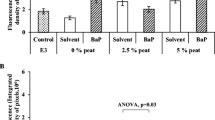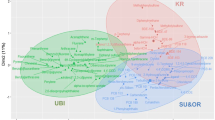Abstract
Goal, Scope and Background
Based on a bioassay battery covering only primary producers and consumers as well as degraders, the potential ecological hazard of sediments to vertebrates cannot be estimated comprehensively. Therefore, there is an urgent need to develop and standardize integrated vertebrate-based test systems for sediment investigation strategies. Whereas vertebrate-based in vitro systems have frequently been used for the investigation of aqueous samples, there is a significant lack of whole sediment assays. Thus, the purpose of the present study was: (1) to develop a rapid and reliable, but comprehensive method to investigate native sediments and particulate matters without preceding extraction procedures; (2) to compare the hazard potential of solid phase sediments to the effects of corresponding pore waters and organic extracts in order to characterize the bioavailability of the particle-bound pollutants; and (3) to relatively evaluate the embryotoxic effects of sediments from the catchment areas of the rivers Rhine, Neckar and Danube.
Methods (or Main Features)
To investigate the toxicity of sediment samples on vertebrates, the standard embryo toxicity test with the zebrafish (Danio rerio; Hamilton-Buchanan 1922) according to DIN 38415-6 was modified with respect to exposure scheme and toxicological endpoints. Sediments from the catchment area of the Neckar River were assessed using pore waters, acetonic extracts and native sediments in order to get inside into the potential bioavailability of particle-bound pollutants. A comprehensive test protocol for the investigation of native sediments in the embryo toxicity test with the zebrafish is presented.
Conclusions
A modified protocol of the zebrafish embryo test allows the assessment of sediment toxicity in both aqueous extracts and native sediments. The isolated investigation of pore waters may result in a clear-cut underestimation of the bioavailability of lipophilic particle-bound substances (as determined by native sediments).
Recommendations and Perspectives
The zebrafish embryo test with native (whole, solid phase) sediments appears very promising for the evaluation of the bioavailable fraction of lipophilic particle-bound substances and can therefore be recommended for the evaluation of vertebrate toxicity in tiered sediment test strategies and dredging directives such as the HABAB-WSV. Whereas acetone extracts may be tested as a rough estimation of embryotoxicity, native sediment samples will provide a more comprehensive and realistic insight into the bioavailable hazard potential.
Similar content being viewed by others
Author information
Authors and Affiliations
Corresponding author
Rights and permissions
About this article
Cite this article
Hollert, H., Keiter, S., König, N. et al. A new sediment contact assay to assess particle-bound pollutants using zebrafish (danio rerio) embryos. J Soils & Sediments 4, 94 (2004). https://doi.org/10.1007/BF02991051
Issue Date:
DOI: https://doi.org/10.1007/BF02991051




